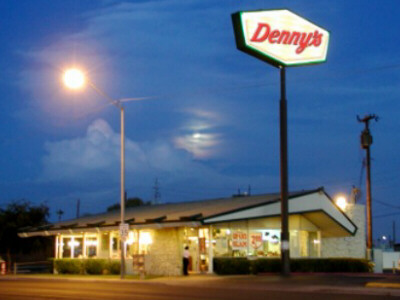|
The future isn't what it used to be,
at least as far as commercial architecture is concerned. In
the 1950's and 60's an evolving building style thrust passersby into
the architect's view of the future. These futuristic creations
which look like they might have been teleported from Tomorrowland or
the Jetsons actually owe their origins to the intense competition
for attention between roadside businesses--primarily coffee
shops--in Los Angeles.
"Serious" architects were aghast by this development.
Editor Douglas Haskell found the style epitomized by the Googies
Coffee Shop at at the corner of Sunset Boulevard and Crescent
Heights in Los Angeles, and dubbed the style as "Googie
architecture" in an article in a 1952 issue of House and
Home. This name swept architectural circles, primarily as
a pejorative reference to design excesses.
Elements of GoogieG1
include:
- Suspension of Gravity --
Portions of the building hang in space without visible means of
support.
- Sheet Glass -- The barrier
against the outside world is a mere force field of a fraction of
an inch of transparent silica.
- Upswept Roofs -- The
better to further the illusion of defiance of gravity and
facilitate the use of glass
- Domes -- If it looks like
a flying saucer, even better!
- Boomerang, Amoebic, Atomic, and
Starburst Shapes -- The less it looks like a building
the better--as long as it would not be out of place in schlock
science fiction.
- Exposed Steel Beams, Rock and
Terrazzo -- Non-traditional and space age materials
replace wood and bricks.
Where coffee shops are concerned, nothing succeeds like excess.
The style spread from its Mecca in LA through the nation.
Phoenix, not infrequently thought of as aspiring to become LA, could
not resist. Though the Googies peaked with the Space Needle at
the 1964 World's Fair, a number of fine examples of this style
remain in Phoenix.
Two prime contributors to Googie in Phoenix were the Dennys and
Big Boy restaurant chains. The first DennysG2
in Phoenix was at Van Buren and 32nd Street. It remains in
nearly pristine condition, proudly displaying the boomerang shape
roof floating above a sheet glass wall. Inside, a large shelf
hovers above the original counter.
JB's is successor to the Bob's Big Boy restaurants in Phoenix.
At first, the restaurants became JP's Big Boy Restaurants.
Then they became just JB's. In an unfortunate attempt to leave
the past behind, JB's smothered the Googie with updated facades.
The result is a building that is neither historic nor modern.
Though the Christown Lanes at Bethany and 19th Avenue opened in
1975, they uphold the finest tradition of 1960's Googie. |
 |
| The boomerang shaped roof floats
atop sheet glass on the 1950's style Dennys at 3217 E. Van
Buren St. Sadly, it is no longer a Denny's, but it was
still standing at our last drive-by in 2008. 7-01 |
 |
| Inside the Van Buren Dennys,
which remains much as it was when it first opened, a large
shelf levitates above the window to the kitchen. 7-01 |
 |
| JB's has attempted to cover its
Googie origins, but the boomerang roof refuses to submit to a
mere stucco facade. 7-01 |
 |
| Proving that Googie was not dead
in 1975, the AMF Christown Lanes opened at 1919 W. Bethany
Home Road, 602-249-1715. 7-01 [Records, Planning &
Zoning, City of Phoenix, 602-262-7800] |
|
Footnotes and Sources for Googie:
G1. Googie
Architecture: A post-WWII architecture style which thrived
in the 1950s and 1960s, featuring bold angles, colorful signs, plate
glass, and pop-culture imagery, resulting in buildings that look as
if they belong in Tomorrowland or Jetsons cartoon. The name is
derived from the 1949 design of Googie's coffee shop at the corner
of Sunset Boulevard and Crescent Heights in Los Angeles. See Googie
Architecture Online, Googie
Central, and Shelby Grad, Googie
Architecture. 
G2. Harold Butler
opened Danny's Donuts in Lakewood, CA in 1953. As more shops were
added in 1954, the menu was expanded and the name changed to Danny's
Coffee Shops. By the end of 1959, there were 20 restaurants in the
chain and the name was changed to Dennys Coffee Shops. In 1963 there
were 78 restaurants in seven western states. History
of Dennys, accessed 7-9-01. 
Alan Hess, Googie: fifties coffee shop architecture,
Chronicle Books, San Francisco, 1985.
Kurt Andersen, "DESIGN: LEGACY OF THE GOLDEN
ARCHES HIGHBROWS CELEBRATE LOWBROW FAST-FOOD ARCHITECTURE." , Time,
06-02-1986, pp 71. |


